Services on Demand
Journal
Article
Indicators
-
 Cited by SciELO
Cited by SciELO -
 Access statistics
Access statistics
Related links
-
 Cited by Google
Cited by Google -
 Similars in
SciELO
Similars in
SciELO -
 Similars in Google
Similars in Google
Share
Infectio
Print version ISSN 0123-9392
Infect. vol.14 no.2 Bogotá Apr./June 2010
1 Faculdade de Medicina-Universidade Comunitária da Região de Chapecó, UNOCHAPECÓ.
2 Departamento de Análises, Universidade Federal do Rio Grande do Sul, UFRGS.
Recibido: 12/01/2009; Aceptado: 03/05/2010
Abstract
Objetive: This work describes demographic and clinical characteristics of individuals with accidental tetanus in Santa Catarina, Brazil.
Materials and Methods: 291 cases of accidental tetanus reported from 1998 to 2008 were analyzed retrospectively through a cross-sectional, descriptive and correlated study based on percentage and numeric frequency as well as on number and incidence rate (i.r.) found in compulsory notification forms.
Results: Most cases (73,54%) occurred among men residing in Vale do Itajaí (30,24%). The age group with the highest incidence was within the 35 to 49 range (32,30%). Complete immunization history was reported in seven cases (2,40%), the perforating injury being the most observed and the lower limbs the most affected ones.Among the reported cases, 87,62% were confirmed; 114 (39,17%) patients died.
Conclusions: Accidental tetanus in Santa Catarina affects the population in a significant way despite the fact that it is an immune preventable disease. The authorities and administrators must plan strategies to address changes in public policies related to immunization coverage of the susceptible population, mainly adults. Above all, it is important to warn society that the success of immunization programs depends on the application of three doses at set intervals, application of booster doses and compliance with the vaccination schedule.
Keywords: Tetanus, Epidemiology, Clostridium tetani.
Resumen:
Objetivo: El presente trabajo describe las características demográficas y clínicas de los individuos con tétanos accidental en Santa Catarina, Brasil.
Materiales y métodos: se analizaron 291 casos de tétanos accidental reportados desde el año 1998 hasta 2008, a través de un estudio descriptivo tipo corte transversal. Con base en el porcentaje y frecuencia numérica, así como en la tasa de incidencia registrada según los formularios de notificación obligatoria.
Resultados: La mayoría de los casos (73,54%) ocurrieron en los hombres que residen en Vale do Itajaí (30,24%). El grupo con mayor incidencia fue en el rango de edad de 35 a 49 años (32,30%). La historia completa de inmunización se informó en siete casos (2,40%), la lesión perforante fue la más observada, las extremidades inferiores fueron las más afectadas. Entre los casos reportados 87(62%) fueron confirmados; 114 (39,17%) pacientes murieron.
Conclusiones: el tétanos accidental en Santa Catarina afecta a la población de manera significativa a pesar del hecho de que es una enfermedad prevenible. Las autoridades y los administradores deben planear estrategias para generar cambios en las políticas públicas relacionadas con la cobertura de inmunización de la población susceptible, sobre todo los adultos. Es importante advertir a la sociedad que el éxito de los programas de inmunización depende de la aplicación de tres dosis a intervalos establecidos, la aplicación de las dosis de refuerzo y el cumplimiento del calendario de vacunación.
Palabras claves: Tétanos, Epidemiología, Clostridium tetani.
Introduction
Since ancient times, tetanus has been plaguing humanity, and it is estimated that there are from 500 thousand to one million cases a year in the world, especially in underdeveloped countries (1). Its incidence is related to the socio-cultural, hygienic-sanitary and immunological state of the population, which explains the high incidence in these countries in contrast to the low level observed in industrialized countries (less than 0.07 cases per 100,000 inhabitants a year) (2).
Tetanus is an infectious disease, usually of sudden onset, resulting from contamination of a wound by Clostridium tetani. The clinical manifestations are due to a potent neurotoxin that produces painful spasms and skeletal muscle rigidity (3). It may also occur as a complication of burns, puerperal infections, umbilical stumps (neonatal tetanus), and surgical site infection mainly manifested by a neuromuscular dysfunction (4). The disease does not develop immunity, and this can only be achieved through vaccination with tetanus toxoid (5).
In Cuba, the campaign against this disease started in 1962, and its major impact was achieved in 1992 with a great reduction represented by a rate of 0.1 x 100,000 cases.Neonatal tetanus has been eliminated since 1972. By the end of 2002, the rate was 0.0 x 100,000 cases (Statistical Yearbook of Health in Cuba, 2002). Nowadays, this disease shows an epidemiological profile in Cuba similar to the profile in developed countries, which is basically characterized as rare (2).
Despite being a satisfactorily preventable disease, since there is a cheap and effective vaccine available, it keeps reaching and killing teenagers, adults and especially elderly people (6). According to the World Health Organization, the estimation of tetanus incidence in the United States and the European Region in 90 years was 0.15 and 0.8 per million of inhabitants, respectively (4).
The first records about the incidence of accidental tetanus, found at the Epidemiological Surveillance Direction Office of Santa Catarina State Health Department (Dive / SES / SC), Southern Brazil, date from 1975. That year, the incidence was 0.7 cases per 100,000 inhabitants. Then, there was an increase in the incidence up to 3.2 cases per 100,000 inhabitants in 1983. After 1983, this rate has been decreasing down to 0.5 per 100,000 in 1999. Despite the apparent reduction in those rates, they can still be considered high when compared to the rates of countries like the United States of America (USA), which showed a rate of 0.015 per 100,000 inhabitants from 1995 to 1997 (6).
Spore tetanus enters the body through a trauma; therefore, the infection is associated with agricultural work and tends to be more common in rural areas of developing countries, while it is associated with sports and outdoor activities in developed countries.The estimate of the tetanus incidence in the United States and in the European Region in 90 years, according to the World Health Organization, was 0.15 and 0.8 per million of inhabitants, respectively (2).
Despite wide availability of a safe and effective vaccine against tetanus, 287 cases of this disease were reported from 1998 to 2008 in Santa Catarina. It suggests the need for adult vaccination programs and/or a plan to educate people in order to make them able to recognize the early symptoms and then seek medical attention quickly (3). In developing countries, tetanus is the major cause of death in newborns, and in developed countries, it can still cause death among adults, particularly after people reach 50 years of age (3). However, the overall incidence of tetanus has decreased slightly, from 0.20 to 0.15, since the late 1980’s and early 1990’s mainly due to the incidence decrease among persons older than 60 and younger than 20 (7).
This study aims to describe the demographic and clinical characteristics of patients with accidental tetanus, reported and treated in the State of Santa Catarina, Southern Brazil, from 1998 to 2008.
Materials and Methods
The information was obtained through analysis of compulsory notification forms; the original data comes from the Epidemiological Surveillance Direction Office of Santa Catarina State Health Department, Brazil.There were records, examined and classified, of 291 patients which had been reported confirmed and / or unconfirmed from 1998 to 2008 in the State of Santa Catarina.
The following variables were analyzed: gender, age, occupation, vaccination history, type of injury, injury site, progress of the case, and city of residence. The macro-regions of the state were considered according to IBGE, Brazilian Institute of Geography and Statistics, as shown in Figure 1.
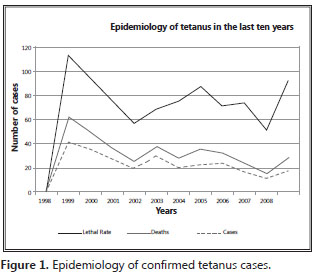
This study was cross-sectional, descriptive and correlated, based on percentages and numeric frequency as well as on number and incidence rate (i.r.) found in compulsory notification forms. Prevalence of this study’s sample analysis is limited to a period of ten years in the whole State of Santa Catarina.
Results
After ten years of analysis, there was an equivalent distribution from 1999 to 2006, highlighting a sharp decline in the number of cases in 2008 compared to 1998, which showed an i.r. of 0.7 X 100,000. 73.54% of the estimated patients were males and the rest were females, with an i.r. of 1.18 X 100,000.The largest share of persons who suffer from tetanus is in the 35 to 49 years old range (32.30%). However there were cases in children below 10 (1.37%) and in elderly persons 80 and older (4.46%) reported, as shown in Table 01.
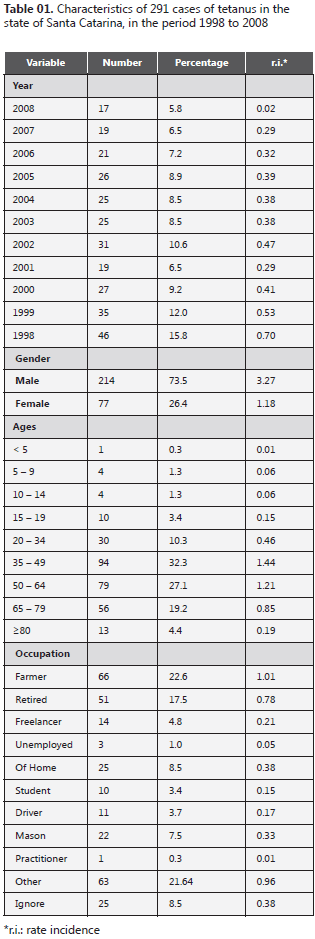
In relation to the occupation, 22.68% of those affected by tetanus were agriculturists, 17.52% were retired people, and only one health care professional case (0.34%) can be highlighted. About the vaccination history, it can be observed that 103 patients (35.39%) had never been vaccinated, and only 39 had received one dose of the tetanus vaccine (13.40%). However, the largest part (40.89%) of the notified cases lacked a vaccination history in the inquiry form.
The data related to the lesion site revealed that the lower limbs were the most affected during the study period, representing a percentage of 58.76 compared to only 67 cases with lesions in the upper limbs. The type of lesion most found was drilling, with 93 notifications, followed by lacerations (12.71%) and excoriations (10.65%).
Out of the 291 cases of tetanus reported in Santa Catarina, 255 cases (87.6%) were confirmed, while the rest were discarded. Nine cases were ignored, 165 were cured, and 114 patients (39.17%) died. (Table 03)
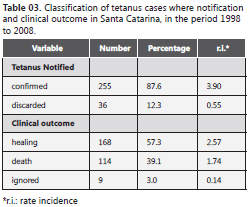
The region of Santa Catarina that had the highest number of tetanus cases in the study was Vale do Itajaí, with a percentage of 30.24. On the other hand, the region with the lowest number of tetanus is called Planalto, with seven cases which represent 2.40% of the total.
As shown in Figure 01, the lethality rate showed a peak in 1999. Right away, there was an emphatic decrease until 2002, becoming high again from 2003 to 2005. In the following period, the case fatality rate was stable, with a similar increase and decrease.Figure 02 shows that, from May to October, the number of cases remained balanced.However, an increase in the number of reported cases of tetanus in the following months, when there were higher temperatures, can be observed.
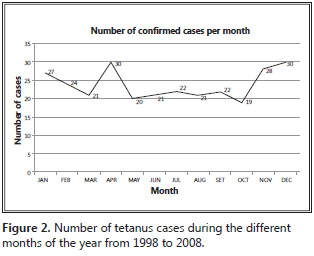
Discussion
The analysis in Table 01 shows that, out of the last ten years, the year with the largest number of cases of tetanus in Santa Catarina was 1998, with a total of 46 cases which represents 15.80%. On the other hand, 2008 had the lowest number of cases reported in Santa Catarina, only 17. This difference of 29 cases may be due to an increase in immunization coverage in this state.
The incidence of tetanus in the United States, as well as its morbidity and mortality, has declined substantially since the mid-1940’s, when tetanus toxoid became universally available (8). This decline was a result of widespread use of vaccines containing tetanus toxoid (TT) for vaccination of infants and children. Vaccination coverage with TT among school-aged children in the United States has improved substantially with the Government’s adoption and implementation of vaccination requirements (8). In regard to gender, the majority of tetanus instances occurred to males, and the number of professional agriculturists and construction workers who suffered this disease may be explained since the presence of men is very common in these professions. Females rank second position representing a total of 26.46% in that category as showed on Table 01. Out of the occupations, the housewife represents the largest number of women patients with 25 cases (8.59%).
Despite considerable investment in tetanus prophylaxis, it is still present throughout the national territory. Males stand as the most affected population, probably due to their exposure to outdoor work. Therefore, tetanus constitutes an occupational risk for workers, especially those in the construction industry, agriculture and animal husbandry.Although male workers run various risks arising from daily work, these workers are not included in the routine immunization schedule, becoming the most constant victims of accidental tetanus (1, 4).
The age group with the largest number of cases was the one ranging from 35 to 49 with a total of 94 cases (32.30%), probably because people are very active professionally in this stage of life. The age group ranging from 50 to 64 follows probable due to the fact that there was an increase in individuals who stopped taking the tetanus vaccine.According to Petrovic et al. (2006) (9), tetanus has almost been eliminated in persons below 29 in Vojvodina due to the extremely high vaccination coverage, and nowadays the problem is concentrated among the elderly, and most likely tetanus victims 66 and older are the ones who die.
Although the number of tetanus cases among the elderly does not constitute the largest group, studies show that in the United Kingdom from 30 to 50 cases are reported per year (4,8). In this country, tetanus has been characterized as a disease of the elderly since 50% of the cases and related deaths happen to patients 60 and older. In São Paulo and Rio Grande do Sul, a clear prevalence of tetanus in older age groups was observed, especially in women (10), unlike the United States where protective titers were observed in only 27.8% of the population 70 and older (8). The immunosenescence not compensated by booster doses of the vaccine would justify this tendency (10). In Nigeria (11), a retrospective study showed that the highest incidence in the number of tetanus cases occurred to patients with a mean age of 29.8. From the 79 patients studied, 70.88% were male and 23 patients were women. About 57% of patients were below 30.
The data in Table 02, related to the clinical characteristics of the tetanus cases in Santa Catarina, shows that out of 291 cases, 103 patients were unvaccinated, which corresponds to 35.39%. This number shows the lack of public information or non-inclusiveness of the vaccination program. Seven patients were reported with tetanus and had their vaccines up to date. So, in 2.4% of the cases the vaccine had not had the expected efficacy. In areas of greater socioeconomic and cultural development, whose population is systematically vaccinated, tetanus is rare (1).
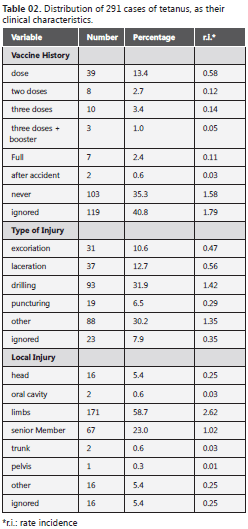
In developed countries, tetanus has become rare thanks to the prophylactic measures and socioeconomic and cultural development, which allows proper immunization of the population and appropriate care to traumatized patients and to birth procedures, as opposed to eliminating bacilli from the floor or breaking the transmission chain of the disease (4).Tetanus in these countries persists especially among the elderly. This is mainly due to the linear decline in the serum levels of tetanus antitoxin with age, to the immune-senescence in detriment of cellular immunity activity (9), as well as to the lack of attention to booster doses of the anti-tetanic vaccination (10).
The more vulnerable lesion site, as expected, was the lower limbs, since most of the time victims are in contact with ground. The lower limb injuries represent a total of 171 cases (58.76%) versus 67 (23.02%) upper limbs injuries. In two cases the oral cavity was the gateway to the C. tetani, a situation little known in studies. By relating type of injury to occupation, it was observed that these accidents might have happened at work due to the instruments used. As noted, the feet were the most affected body part, probably as the result of the habit of walking and working barefoot, a situation that can be prevented by wearing appropriate shoes for professional practice, thus allowing the reduction of this disease (1).
If it were possible to characterize a tetanus case as the most common one in Santa Catarina from 1998 to 2008, it would be a 35 - 49 years old man, a countryman unvaccinated against tetanus who suffered a perforating injury in the inferior limbs and lives in Vale do Itajaí. This case would be confirmed and would evolve into cure, as shown in table 03.
The type of injury that served as the biggest gateway for Clostridium tetani from 1998 to 2008 in Santa Catarina was perforation, with a percentage of 31.96 representing an i.r. of 1.42 X 100,000. This information was also presented by Feijão et al. (2007) (1) in his retrospective study about accidental tetanus in Ceará, Brazil from 2002 to 2005. In this study, carried out in that Brazilian northeastern state, the percentage of perforating injuries was 40.50.
Regarding the number of cases distributed in different geographical regions, Vale do Itajaí was the predominant one with 88 cases (30.24%). Although there are not studies that justify the reason for the high rate of tetanus cases reported in this region, the data suggest that this probably happens because Vale do Itajaí has the largest river and sea port of Santa Catarina, where millions of people and goods circulate every year.In addition, the tropical maritime climate should be considered as a determinant for this number because it facilitates the high level of physical agent oxidation, providing ideal conditions for the spread of C. tetani.With an essentially agricultural population, the western region presents 27.14% of the tetanus cases in Santa Catarina, as shown in table 4. It is important to note that the etiologic agent of this disease is a usual ground inhabitant, and its sporulated bacillus character makes it highly resistant to adverse environmental conditions such as droughts and high temperatures (11).
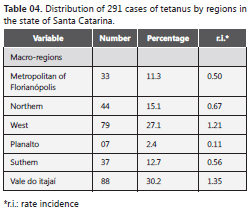
It is important to point out that, in addition to lack of vaccination campaigns, other factors influence the emergence of new tetanus cases. Some important measures to be taken into consideration can be mentioned (12,13,14): search for a better diagnosis and records of the true causes of death; more extensive coverage of medical care; better birth conditions thus avoiding neonatal tetanus; improvement in general and sanitary education; increase of the general population schooling level; reduction in the number of empirical dentists; improvement in communication means in order to provide information for the population about the necessary precautions against the disease and other prevention measures.
All these factors influence the overall health status of the country. However, adequate vaccination coverage plays an important role because, when the cases are analyzed individually, a flaw in this sector becomes evident. The basic immunization involves the application of three doses with an interval of two months between the first and second doses, and the third dose should be applied six to twelve months after the second. In short, the success of immunization programs depends on the correct application of the doses, application of booster doses, and compliance with the vaccination schedule.
Despite all the care and the decrease or even disappearance of tetanus cases, it is necessary to keep an eye out for susceptible individuals since this disease will never be eradicated as its etiologic agent lives on soil, its natural habitat.
Acknowledgments
We would like to thank all collaborators who helped develop this study, especially the employees at the Epidemiological Surveillance Direction Office of Santa Catarina State Health Department, Elaine Tritany and Edi Sperandio and the Surveillance Division of Chapecó City, Santa Catarina, Brazil.
Corresponding author: Departamento de Análises, Universidade Federal do Rio Grande do Sul. Avenida Ipiranga, 2752, 604 Santa Cecília 90610-000 - Porto Alegre, RS - Brasil e-mail: alexmf77@gmail.com
References
1. Feijão AR, Silva de Brito DM, Peres DA, Gimenez Galvão MT. Tétano acidental no estado do Ceará, no período de 2002 e 2005. Revista da Sociedade Brasileira de Medicina Tropical. 2007; 4: 426-430. [ Links ]
2. Venero Fernández SJ, Machado AM, Fernández MG, Fernandez Ceballos MC. Tétano infantil. Revista cubana de higiene e epidemiologia. 2006; 44: 2-10. [ Links ]
3. Ergonul O, Erbay A, Eren S, Dokuzoguz B. Analysis of the case fatality rate of tetanus among adults in a tertary hospital in turkey. European Journal of Clinical Microbiology & Infectious Diseases. 2003; 22: 188-190. [ Links ]
4. Brook I. Current concepts in the management of Clostridium tetani infection. Expert review of anti-infective therapy. 2008; 3: 327-336. [ Links ]
5. Castro L, Gonçalves G, Catarino J. Caracterização epidemiológica de casos declarados de tétano. Acta médica portuguesa. 2004; 17: 225-229. [ Links ]
6. Viertel IL, Amorim L, Piazza U. Tétano acidental no Estado de Santa Catarina, Brasil: aspectos epidemiológicos. Epidemiologia e Serviços de Saúde. 2005; 1: 33-40. [ Links ]
7. Sutiono AB, Qiantori A, Suwa H, Ohta T. Characteristic tetanus infection in disaster-affected areas: case study of the Yogyakarta earthquakes in Indonesia. BMC Research Notes. 2009; 2: 34-40. [ Links ]
8. Bardenheier B, Prevots DR, Khetsuriani N, Wharton M. Tetanus surveillance in United States, 1995-1997. Surveillance summaries. 1998; 47: 1-13. [ Links ]
9. Petrovic V, Seguljev Z, Petrovic M, Ilic S. Epidemiological characteristics of tetanus in Vojvodina. Medicinski pregled. 2006; 12: 551-555. [ Links ]
10. Moraes EN, Pedroso ERP. Tétano no Brasil: doença do idoso? Revista da Sociedade Brasileira de Medicina Tropical. 2000; 33: 271-275. [ Links ]
11. Komolafe MA, Komolafe EO, Ogundare AO. Pattern and outcome of adult tetanus in Ile-Ife, Nigeria. Nigerian Journal of Clinical Practice. 2007; 10: 300-303. [ Links ]
12. Gargano F, Nesi A, Bülow AR, Rocha DS, Oliveira DM. Tétano: características atuais. Jornal Brasileiro de Medicina. 2006; 90: 44-52. [ Links ]
13. Gibson K, Bonaventure Uwineza J, Kiviri W, Parlow J. Tetanus in developing countries: a case series and review. Canadian Journal of Anaesthesia. 2009; 56: 307-315. [ Links ]
14. Vieira LJ. O tétano neonatal no Estado de Minas Gerais: contribuição para a compreensão do problema. Revista Latino Americana de Enfermagem. 2003; 11: 638-644. [ Links ]














